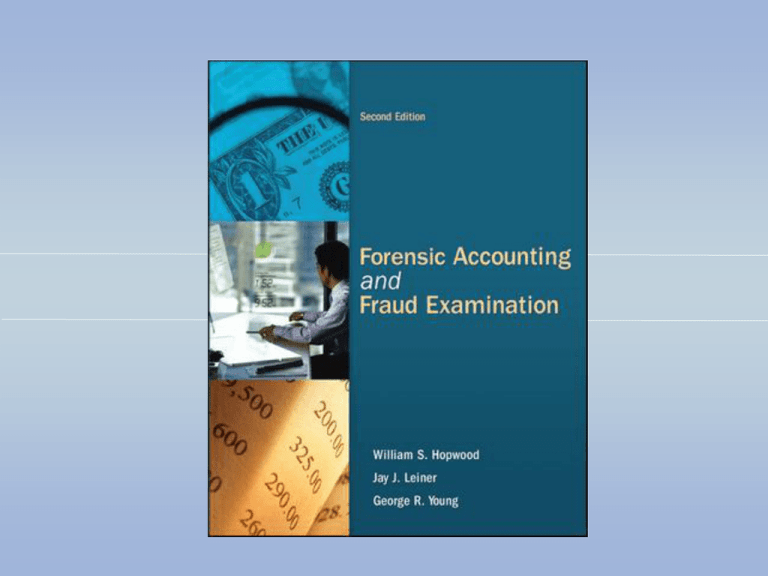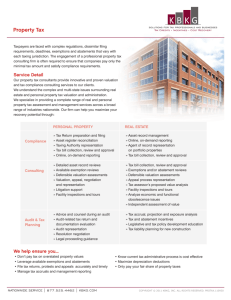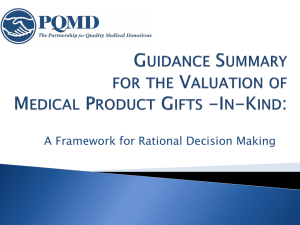
19-1
19-2
19
Business Valuation
McGraw-Hill/Irwin
Copyright © 2012 by The McGraw-Hill Companies, Inc. All rights reserved.
19-3
Business valuation
Business
valuation in the most general sense deals with
the appraisal of various financial assets.
Business entities
Government entities (municipalities).
Real estate (raw land, office buildings, leaseholds).
Securities (common stock, bonds, options).
Intangible assets ( patents, royalties, copyrights, trademarks).
Trusts (all types).
Individual tangible assets (plant and equipment).
Estates (marital, testimonial, bankruptcy).
Contractual rights (buy-sell agreements).
Economic damages and insurance losses (business interruption).
Individual or partial interests in any of the preceding items.
19-4
General Valuation Objectives
There
is no one right way to value an asset, and in many
cases, the process of assigning a single dollar value to a
complex asset is as much art as it is science
Business appraisers strive to achieve results that meet
certain general requirements
Consistency
Ideally, different skilled appraisers should
produce a similar valuation for a given asset.
Defensibility There is always the general possibility that any
valuation could be subjected to legal challenges.
Suitability for purpose Valuations must be suitable to the
purposes and circumstances of the individuals needing the
information.
19-5
The International Valuation
Standards Committee
International
Valuation Standards Committee (IVSC): A
UN organization that works with various national and
international organizations and UN member states to
internationally harmonize valuation standards.
The IVSC publishes the following:
Valuation
concepts and principles.
Code of conduct.
Individual valuation standards.
Applications (of standards).
Guidance notes.
Information papers.
The
IVSC focuses on developing valuation standards
relevant to developing international accounting standards.
19-6
Basic Valuation Theory:
Standards of Value
Key
concepts: standard of value, valuation premises,
valuation approaches, valuation adjustments, and
valuation methods.
Standards of Value (value that is relevant to a particular
entity or individual)
Fair Market Value
Intrinsic or Fundamental Value
Investment Value
Fair Value
19-7
Valuation Premises
Valuation
premise is defined primarily according to the
circumstances surrounding a hypothetical disposition
Two factors define such circumstances: the extent to which
synergistic value is derived from the sale of a group of
assets and the speed or effort of the sale.
Synergy
High
synergy (going concern value premise)
Medium synergy (assemblage of assets value premise) .
No synergy (individual asset disposition premise)
Speed
of Sale
Normal
speed of sale (orderly sale premise)
Fast speed of sale (forced liquidation premise)
19-8
Synergy and the Speed of Sale
19-9
Estimating Market Value: The Fair
Value Hierarchy
Level 0 Based on a sale or exchange of the asset being
appraised.
Level 1 Based on quoted prices for an identical asset that
is traded in a currently active market.
Level 2 Based on quoted prices for a similar asset with
adjustments made for differences between the subject asset
and the similar asset.
Level 3 Based on mathematical models that use directly
related market variables as indicators of market value. Level
4 Based on mathematical models that use indirectly related
market variables as indicators of market value.
Level 5 Based on mathematical models that use internal
business inputs as indicators of market value.
19-10
Using the Valuation Premise and Value
Hierarchy in Financial Reporting
Financial reporting as defined by both U.S. and international
standards is moving away from historical cost reporting and
toward fair value reporting on the balance sheet. With
respect to financial reporting, the normal value premise is
that the business is a going concern and that its assets
would be sold in an orderly manner. Some additional
assumptions also apply.
Marketplace Participants
Most Advantageous Reference Markets
Transaction Costs
Highest and Best Use
Liabilities
19-11
Valuation Approaches
Three
broad valuation approaches are used to value
businesses or other assets: the income approach, the
market approach, and the asset approach
the income approach, an asset’s value is the present
value of the future economic income associated with the
asset.
Under the market approach, the value of the asset is what
the asset can be sold for in an open market within some
reasonable time period.
Under the asset approach, the value of an asset, especially a
business, is the sum of the individual assets that it comprises.
Under
19-12
Valuation Adjustments
Valuations
determined under each valuation approach may
require upward or downward adjustments
Extent
of Ownership Control over Income-Producing Assets
Marketability and Liquidity
Restrictions on Transferability
Business-Specific Risk
facing new, strong low-margin competitors.
19-13
Valuation Estimates
In general, the valuation analyst chooses the approach or
combination of approaches that are most relevant to the
valuation objective. The end result is the final valuation
estimate, which can take two basic forms:
A
single dollar figure For example, the analyst could
determine that the final value estimate for a given business is
$2,235,000.
A range of dollar values For example, the analyst could
determine that the final value estimate is between $1,000,000
and $2,000,000.
19-14
The Process Of Valuing A
Business
The
following also apply to valuing financial assets in
general
Define
the valuation assignment.
Collect and analyze information about the business.
Research the industry in which the business operates.
Study and analyze the business’s financial statements.
Select and apply a valuation method (with related
assumptions given the standard of value, the valuation
premise, and the valuation approach) to produce a valuation
estimate.
Make any appropriate adjustments (as discussed above) to
the valuation estimate to produce a final valuation estimate.
Produce the valuation report.
19-15
Valuation Method Associated with
the Income Approach
The
Discounted-Income Method
Select
a measure of future economic income such as
accounting income or cash flow from operations.
Make a schedule of projected future income or cash flows
using the selected measure. The schedule typically includes
the future income or cash flows for Year 1, Year 2, Year 3,
and so on. All future years are included through some
assumed final terminal year.
Select an appropriate discount rate to be used to compute the
present value of the projected income or cash flows.
Compute the present value of the projected income or cash
flows using the selected discount rate.
19-16
Estimation of Future Income or
Cash Flows
Various
measures of income and cash flows are used as
surrogates for projected economic income.
Projected
accounting income after taxes.
Projected dividends.
Projected free cash flow available to equity (FCFE), defined
as the amount of cash available to shareholders after all
expenses, reinvestment, and debt and preferred dividend
payments.
Projected free cash flow to equity before debt payment,
sometimes called debt-free cash flow available to equity
(DFCFE).
19-17
The Income Approach: The
Capitalized Income Method
The
capitalized income method is a variation on the
discounted income method. The main difference with the
capitalized income method is that the income or cash flows
are assumed to exist for an indefinite period in the future.
When this happens, the present value formula reduces to
very simple terms:
Present Value = Economic Income / Discount Rate
The basic perpetuity model can be expanded to
accommodate growth: PV = EI / (k – g)
19-18
Valuation Methods Associated
with the Market Value Approach
Four
basic steps are involved in the guideline publicly
traded company method: (1) Select guideline companies, (2)
adjust the financial statements of the guideline companies to
make them comparable to the subject company, (3) compute
various price-based financial ratios for the guideline companies,
and (4) apply the price-based financial ratios to the subject
company.
The
guideline method is frequently used by security
analysts who value companies using price-earnings
multiples of comparable companies.
The
price of the subject company equals the price-earnings
ratio of the guideline company times the earnings of the
subject company. Other accounting numbers (e.g., sales) can
be used in place of earnings.
19-19
The Projected Guideline Publicly
Traded Company Method
This
method works the same way as the guideline publicly
traded company method except that the price-based ratios
are based on projected rather than historical accounting
data.
19-20
The Guideline Acquired and
Merged Company Method
The
guideline acquired and merged company method
works the same way as the guideline publicly traded
company method except that the comparative data are
based on acquired and merged companies. This method is
applicable to situations in which a controlling interest is
being valued.
Obtaining comparable data could be difficult, and many
acquisitions involve both cash and other consideration that
may be difficult to value, Finally, many acquisitions may
reflect the investment value of the acquirer (because of
unique synergies between the acquirer and the acquired
company) rather than the general fair market value.
19-21
Valuation Methods Associated
with the Asset-Based Approach
The
primary asset-approach method is the asset
accumulation method. It involves restating, as needed, all
individual assets and liabilities on the balance sheet to market
value (or other value, such as liquidation value, as required by
the appraisal objectives). Next, any off-balance-sheet assets
and liabilities are added to the balance sheet. Finally, the
business is valued as the difference between the resulting
assets and liabilities.
Valuing each asset for anything but a very small company can
be a difficult task. In many cases, the analyst needs to consult
specialized appraisers to estimate individual asset values.
The results are presented in balance sheet format and are
easy to understand, and are appreciated by lenders.
19-22
The Capitalized Excess Earnings
Method
Apply the asset-accumulation method to estimate the value of the
firm.
Estimate the value of goodwill by estimating and capitalizing
excess income using a three-step process:
Estimate a “normal” income for the net assets determined by the
asset-accumulation method. This done by multiplying the value of the
net assets by a rate of return that is determined using factors similar
to those used to determine the capitalization rate in applying the
income approach.
Subtract the normal income from the actual income. The difference
represents the income associated with goodwill (and any assets
excluded from the asset base). This is the excess earnings. In
computing actual income, it is important to adjust the compensation
of owners upward or downward to a reasonable level.
Capitalize the excess earnings
Add the accumulated net assets to the capitalized earnings.








